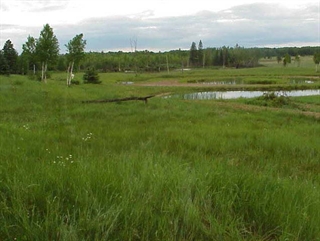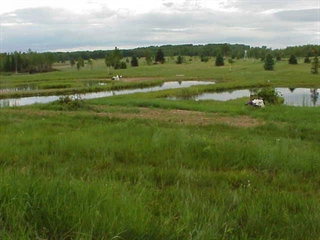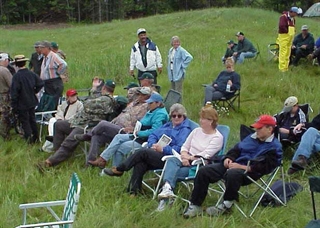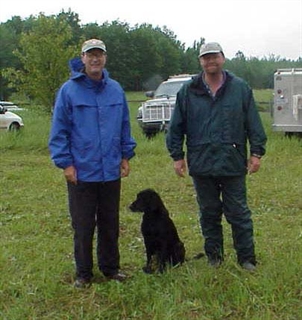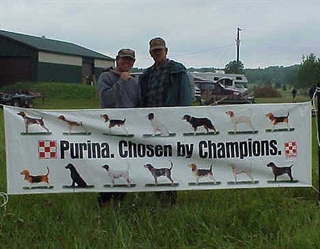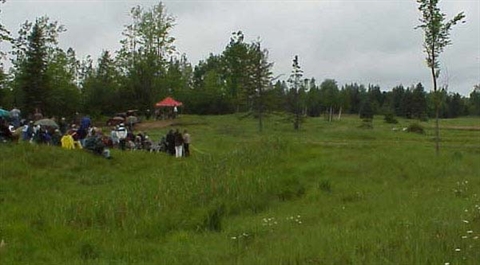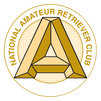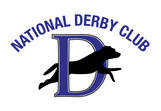Monday, June 19, 2000 |
Test 3
Monday began with overcast skies which turned to showers en route to Test Three, a water triple at the Magnusson property, several miles farther down the road from the LeGrande Ranch. The site faced a series of man made "technical" type ponds surrounded by a rolling, grassy shoreline. Several ponds had cattails in and/or near the shore.
The line was located atop a gentle slope overlooking the site. A set of two guns were stationed to the left. They threw a dead hen pheasant flat to the right where it landed in grassy cover just above the shoreline about 130+ yd. deep. Another pair of guns stood to the near right, nearly straight out from the line. They threw a dead duck angled back from the near shore across a small bay to base of the shore beyond. It splashed into a stand of cattails about 30 yards from line. Lastly, a group of guns located between them shot a flying duck flat to the left. It landed either on the side of a grassy, rolling shore or splashed into a flooded area near the bank about 125-135 yards away. Ducks landing in the water were sluiced. As the dog was sent for the first bird, the left guns retired to a stand of trees behind them. (When the test dogs ran, both outside birds were retired, but when neither test dog could do it without handling the short one was not retired .) The birds were well placed and challenging and the gallery had a fine view of the marks.
The left bird converged with the flyer mark and some dogs seemed confused as to which they wanted. Some selected out the short right one first with varying degrees of success. Varied flyer falls produced numerous hunts and the draw of the left mark was tempting to a few. When sent, some split the difference and arrived between the two - usually they recovered the flyer as scent from the duck kept them in the area. Many hunted the hill above the fall and several went out of sight for a period of time. When sent for the short bird a number over ran it. Some recovered on their own while others required handling. Those that had selected the short bird first usually tried for the flyer next where the same pitfalls awaited them. Angles in and out of the swimming water ponds and across land strips also nudged dogs off a straight line to the marks.
The left, retired mark was close to the shore and was a hen pheasant, wet from the rain. Dogs would charge up the slope, pass the bird and hunt deep beyond, often out of sight. Some paid a visit to the retired gunners and were out of sight in the woods for quite a while. Others seemed to wind the bird, make game, then leave the area - perhaps expecting another duck. Many recovered it on their own, but a few tried to return to the flyer or appeared unable to locate it and requiring handling. In the first rotation of #'s 25-50 there were several handles and pick-ups. That trend lessened later somewhat when switching winds and more scent aided dogs.
A light, intermittent rain continued well into the afternoon until about 3 p.m. when skies cleared and temperatures rose into the 70's.
The 7-9 minute test was extended by no birds and and pick-up dogs for the former. ETA appeared to be well after 8 p.m. and there was some doubt if it would be completed on Monday. Again, if it could not be completed, no partial call backs would be given. If it did complete, call backs would be quite late.
A rumor circulated that if #3 was not completed, a water blind would run at the same site on Tuesday. If it did complete, the stake would return to the LeGrande farms instead. Test four would begin with dog # 50.
Welcome news arrived. Karon Richardson had undergone surgery and was doing well although more would be needed later. Unwelcome news was that the McIllwain's brand new PT Cruiser had hit a deer and would need extensive repairs.
Test three was suspended at 8 p.m. after dog 15 had run with 10 left to run Tuesday morning. (Dog 14 had a no bird and will not run until Tues. a.m.) Test dog will run at 7:30 a.m. with the first running dog (16) at 8 a.m.
The site rumor proved false as a caravan is scheduled to leave site three after completion for a different area.
As promised, no partial call backs were given.
The line was located atop a gentle slope overlooking the site. A set of two guns were stationed to the left. They threw a dead hen pheasant flat to the right where it landed in grassy cover just above the shoreline about 130+ yd. deep. Another pair of guns stood to the near right, nearly straight out from the line. They threw a dead duck angled back from the near shore across a small bay to base of the shore beyond. It splashed into a stand of cattails about 30 yards from line. Lastly, a group of guns located between them shot a flying duck flat to the left. It landed either on the side of a grassy, rolling shore or splashed into a flooded area near the bank about 125-135 yards away. Ducks landing in the water were sluiced. As the dog was sent for the first bird, the left guns retired to a stand of trees behind them. (When the test dogs ran, both outside birds were retired, but when neither test dog could do it without handling the short one was not retired .) The birds were well placed and challenging and the gallery had a fine view of the marks.
The left bird converged with the flyer mark and some dogs seemed confused as to which they wanted. Some selected out the short right one first with varying degrees of success. Varied flyer falls produced numerous hunts and the draw of the left mark was tempting to a few. When sent, some split the difference and arrived between the two - usually they recovered the flyer as scent from the duck kept them in the area. Many hunted the hill above the fall and several went out of sight for a period of time. When sent for the short bird a number over ran it. Some recovered on their own while others required handling. Those that had selected the short bird first usually tried for the flyer next where the same pitfalls awaited them. Angles in and out of the swimming water ponds and across land strips also nudged dogs off a straight line to the marks.
The left, retired mark was close to the shore and was a hen pheasant, wet from the rain. Dogs would charge up the slope, pass the bird and hunt deep beyond, often out of sight. Some paid a visit to the retired gunners and were out of sight in the woods for quite a while. Others seemed to wind the bird, make game, then leave the area - perhaps expecting another duck. Many recovered it on their own, but a few tried to return to the flyer or appeared unable to locate it and requiring handling. In the first rotation of #'s 25-50 there were several handles and pick-ups. That trend lessened later somewhat when switching winds and more scent aided dogs.
A light, intermittent rain continued well into the afternoon until about 3 p.m. when skies cleared and temperatures rose into the 70's.
The 7-9 minute test was extended by no birds and and pick-up dogs for the former. ETA appeared to be well after 8 p.m. and there was some doubt if it would be completed on Monday. Again, if it could not be completed, no partial call backs would be given. If it did complete, call backs would be quite late.
A rumor circulated that if #3 was not completed, a water blind would run at the same site on Tuesday. If it did complete, the stake would return to the LeGrande farms instead. Test four would begin with dog # 50.
Welcome news arrived. Karon Richardson had undergone surgery and was doing well although more would be needed later. Unwelcome news was that the McIllwain's brand new PT Cruiser had hit a deer and would need extensive repairs.
Test three was suspended at 8 p.m. after dog 15 had run with 10 left to run Tuesday morning. (Dog 14 had a no bird and will not run until Tues. a.m.) Test dog will run at 7:30 a.m. with the first running dog (16) at 8 a.m.
The site rumor proved false as a caravan is scheduled to leave site three after completion for a different area.
As promised, no partial call backs were given.

